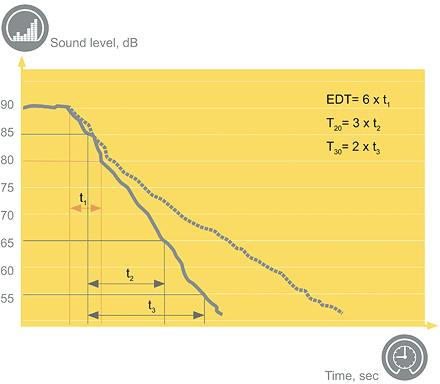Reverberation time

The reverberation time is defined as the time it takes for sound to decrease by 60 dB. To determine the lenght of this time, different parts of the reverberation curve are used.
The descriptors T20 and T30 are usually called “late reverberation times” as they measure at the later part of the curve. EDT is called “early reverberation” and is considered to better reflect how we perceive the reverberance in the room.
When measuring Early Decay Time (EDT), an interval of 10 dB is used.
At T20, an interval of 20 dB is used. When determining T20, the evaluation does not start until after the sound level has already fallen by 5 dB.
At T30, an interval of 30 dB is used and here too, the evaluation starts after the sound level as fallen by 5 dB.
If the reverberation curve is straight, the EDT, T20, and T30 will all produce the same value. In practice, the reverberation curve is seldom straight (dashed line), which means that the descriptors will differ.
| Perceived attribute | Objective descriptor | Designation | Unit | Explanation | Standard |
| Reverberance (echo) | Reverberation times | EDT, T20, T30 | Second (s) | Measures speed at which sound disappears in a room. | ISO 3382-1 / 2 |
